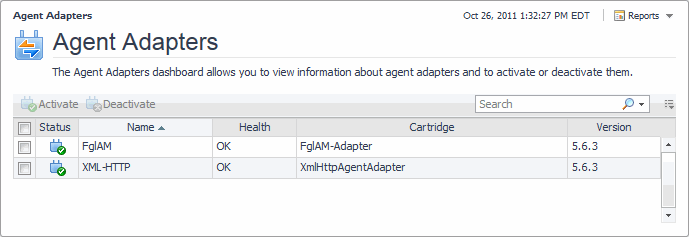Viewing Agent Adapters
The Agent Adapters dashboard allows you to view information about agent adapters and to activate or deactivate them, if instructed by Quest Support. To access this dashboard, from the navigation panel, click Dashboards > Administration > Agents > Adapters.
For more information, see the following topics:
Controlling System Access with Credentials
The Credentials dashboard provides quick access to credentials and lockboxes. This dashboard provides at-a-glance information about the current state of credentials, lockboxes, credential clients, the alarms they generate, and cartridge-specific credential views. Use it as a starting point for your credential management needs. To access this dashboard, on the navigation panel, click Dashboards > Administration > Credentials.
For more information, see the following topics:
For more information, see the following topics:
For more information, see the following topics:
For more information, see Explore the View Clients dashboard.
Administering Foglight
This section focuses on recommended maintenance tasks that ensure optimal Foglight® performance. It also describes the starting points in Foglight administration.
As a starting point, this topic assumes a stable installation which, at minimum, contains the following configuration components:
Finally, this topic addresses the ongoing maintenance tasks required to ensure your Foglight Management Server stays operationally healthy.
Generally speaking, most of the tasks required to ensure a stable installation can and should be automated. For example, there is not much value in asking a Foglight administrator to log in only to ensure it is running or check to see if there is enough memory when rules and automated emails can be generated to notify administrators of potentially worrisome conditions. As such, the first part of this topic identifies the automatable self-monitoring options that should be configured. The rest of the topic covers:
For more information, see the following topics:
Recommended Self-Monitoring Automation
A separate Remote Monitor process can be configured to watch the Foglight® High Availability (HA) process and notify an administrator in the event that the Foglight Management Server process unexpectedly shuts down. Configure the Remote Monitor process to ensure that an administrator is notified when the Foglight Management Server shuts down. For more information about the Remote Monitor process and running Foglight in HA mode, see the Foglight High Availability Field Guide.
A set of rules covering the critical health items for a Foglight Management Server is delivered with the Core-Monitoring Policy cartridge, included with the server install.This cartridge is installed and enabled during the server installation. Email notifications should be set-up for each of the rules delivered in this cartridge. To configure email notifications, use the Email Configuration dashboard. To access this dashboard, from the Administration dashboard, under Support, click Email.

